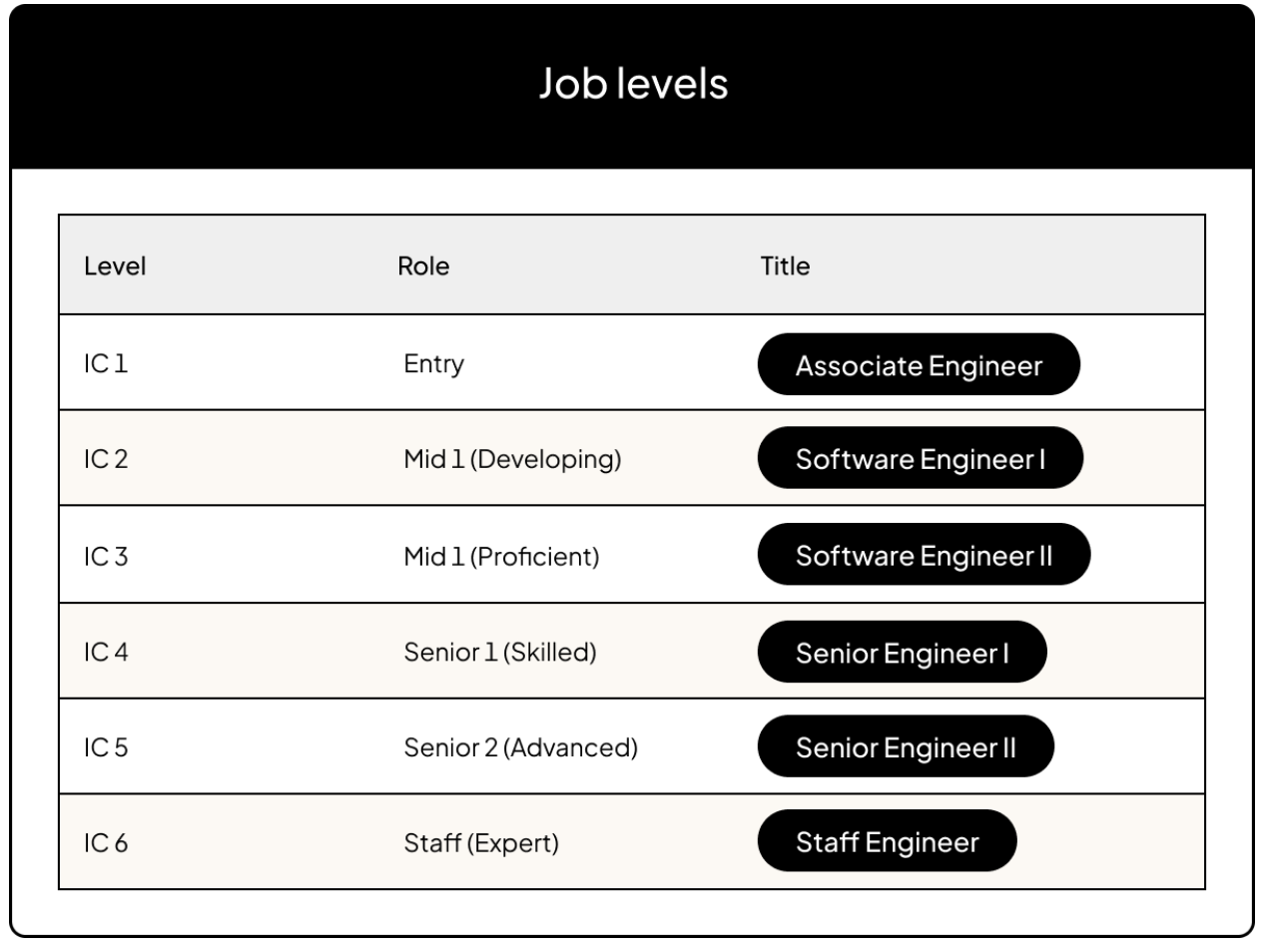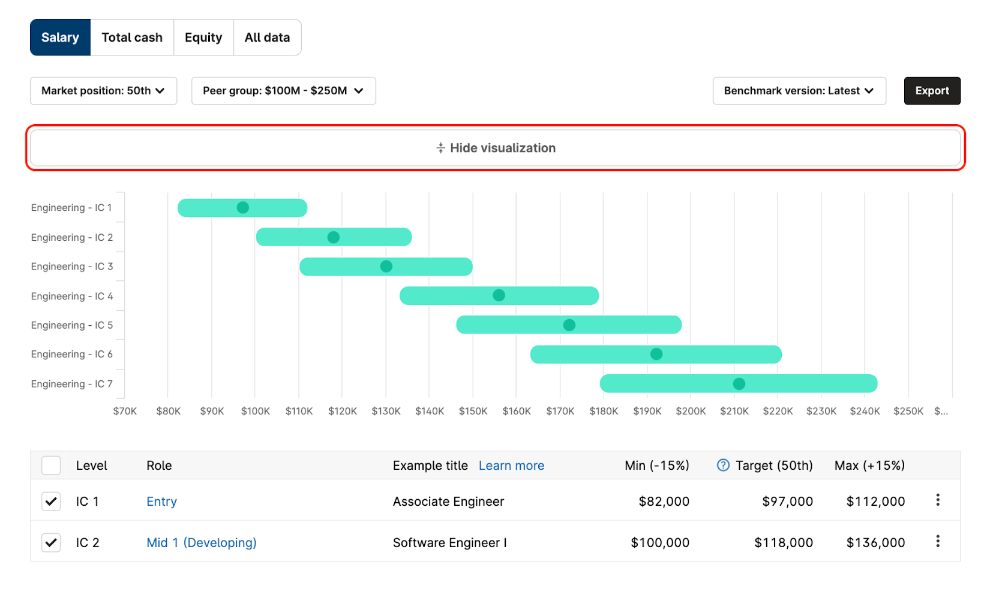What are salary bands?
Salary bands, also known as "compensation bands" or "pay bands," show the minimum and maximum amount a company is willing to pay employees within a job level. These bands are not just arbitrary figures; they are thoughtfully structured to reflect the level of responsibility, skill, and experience required for each role within an organization. Salary bands reflect a company’s overall compensation strategy and play an important role in attracting and retaining top talent.
Pay range vs. salary band
While a pay range is specific to a job and its requirements, a salary band is a broader categorization used to group similar jobs or levels of job responsibilities. Pay ranges fit within salary bands, and together, they form a part of an organization's compensation strategy.
Pay range
A pay range refers to the spectrum of compensation (minimum to maximum) that an employer is willing to pay for a specific job or position. Pay ranges account for variations in experience, education, skills, and performance. Employers use these ranges to determine how much to offer a new hire or how much to increase an employee's salary during a promotion or review cycle. The range also provides flexibility to accommodate different levels of expertise and performance within the same job or position.
For example, the pay range for a marketing manager position might be $100,000 to $125,000 per year. A more experienced and skilled candidate might be offered a salary closer to the upper limit, while someone with less experience might receive an offer closer to the lower end.
Salary band
A salary band is a broader classification used to group positions with similar levels of responsibility and qualifications. Each band or grade has its own pay range. Salary bands are part of a structured pay system, commonly used in large organizations or government entities. They help in standardizing compensation across the organization and in maintaining pay equity. Positions are classified into bands based on evaluation of the responsibilities, duties, and qualification for the positions.
For instance, a marketing team might have salary bands labeled from one to eight. Band One could include entry-level social media, demand generation, and editorial positions with a pay range of $30,000 to $45,000, while Band Eight could include VP positions with a pay range of $250,000 to $300,000.
How to create and implement salary bands
Salary bands are created in conjunction with job levels. Job levels define the hierarchy of roles within an organization, while salary bands assign a range and midpoint of compensation to these levels. Together, they provide a structured, transparent, and fair framework for employee compensation, aligning pay structure with responsibilities, experience, and market research .
Review your compensation philosophy
Your company’s compensation philosophy is the framework for all your decisions around salary, variable compensation, equity, and certain benefits. Refer to it and use it to help you as you make pay decisions and define new salary bands.
Define job levels
Review the job descriptions of current employees and prospective hires. Then define various job levels based on these roles' responsibilities, required qualifications, experience, and complexity. These levels might include entry-level positions, mid-level positions, senior roles, management, and executive levels.
The example below shows the type of role and title that could correspond to different job levels of “ICs,” or individual contributors (as opposed to managers):

Each job level has specific criteria that outline the expectations, skills, and responsibilities required. For example, entry-level positions may require less experience and focus on learning and executing tasks, while senior roles may involve strategic decision-making and leadership.
Establish salary bands
For each job level, establish a salary band. This band defines the minimum and maximum salary range for positions within that level. The salary bands are designed to reflect the value and complexity of the roles in each job level. While salary bands for different job levels may have some overlap, higher job levels will have higher salary targets and midpoints to compensate for the increased responsibilities and skills required.
Understanding market data is crucial for establishing salary bands; setting salary bands too low, in relation to other companies with which you’re competing for talent, can result in not bringing in the new hires needed for growth. Conversely, setting them too high results in unnecessary spending.

Align job levels with salary bands
Assign each job within your organization to a job level and corresponding salary band. For instance, a 'Junior Analyst' might be at a lower job level with a corresponding lower salary band, while a 'Senior Analyst' would be at a higher level with a higher salary band.
This alignment ensures that employees with similar responsibilities and qualifications are compensated in a similar range, maintaining internal equity.
Determine compensation within salary bands
Within each salary band, individual compensation can vary. Factors influencing where an employee falls within the band include experience, performance, tenure, and market factors. So someone with more job experience may have a different salary than someone else with less experience, even if they have the same role.
Consider promotions and career progression
Job levels and salary bands give employers and employees clarity on what’s required for promotions and raises, which is helpful for future salary negotiations and performance reviews.
As employees progress in their careers, they often move to higher job levels with different responsibilities, which would lead to a higher salary band. But, if they’re getting a raise instead of a promotion, they’d move up within their existing salary band.
Review and adjust
It’s important to periodically review and adjust your salary bands and job levels to remain competitive and fair. Look at market trends, cost of living adjustments, and the overall financial health of your organization.
Advantages of salary bands
Creating clear salary bands for different job levels at your company not only creates more pay transparency and trust with employees, but it also helps recruiting, HR professionals, and finance to better prepare for hiring and promotion cycles.
-
Promotes equity and transparency: Salary bands ensure that employees in similar roles with comparable experience and skills are compensated fairly.
-
Simplifies salary negotiation: With predefined ranges, both employers and employees have a clear starting point for salary discussions.
-
Enhances strategic planning: For CFOs, salary bands aid in financial forecasting and budgeting for human resources.
-
Improves job satisfaction: Transparent salary structures can enhance employee morale and job satisfaction when communicated clearly.
-
Better market alignment: Updating salary ranges regularly helps keep pay competitive with industry standards.
While there are many benefits to creating and maintaining salary bands, in some cases, strict adherence to salary bands can prevent attracting top talent with higher pay expectations. It’s also important to regularly adjust salary bands so they stay aligned with market rates and your overall talent strategy.
Compensate competitively with Carta Total Compensation
Get the most informed compensation recommendations for every role, level, and region with Carta Total Comp. Our real-time benchmarks are based on the most comprehensive and accurate private market data and can help you ensure you’re offering fair and competitive compensation to win and retain top-notch talent. Plus, machine learning technology ensures our compensation data reflects market changes, so you’re never making compensation decisions based on outdated data.




